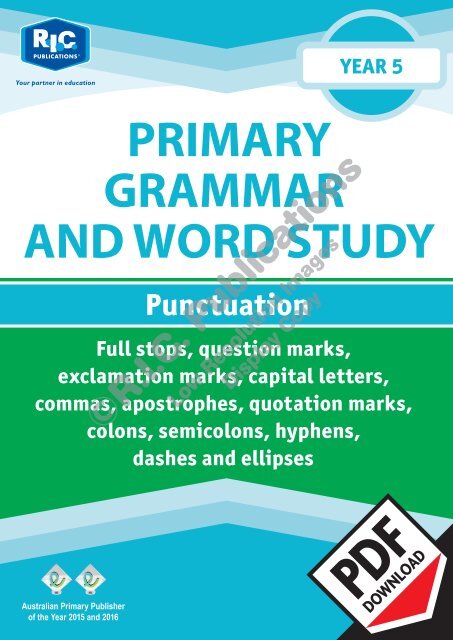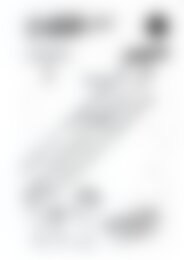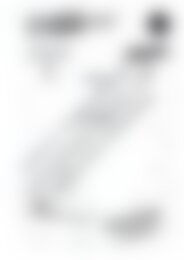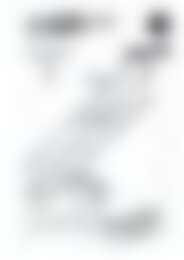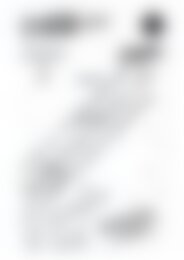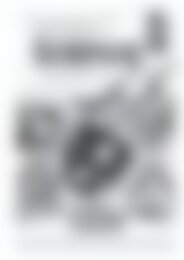RIC-20244 Primary Grammar and Word Study Year 5 – Punctuation
Create successful ePaper yourself
Turn your PDF publications into a flip-book with our unique Google optimized e-Paper software.
Your partner in education<br />
YEAR 5<br />
PRIMARY<br />
GRAMMAR<br />
YEAR 1<br />
AND WORD STUDY<br />
<strong>Punctuation</strong><br />
Full stops, question marks,<br />
exclamation marks, capital letters,<br />
commas, apostrophes, quotation marks,<br />
colons, semicolons, hyphens,<br />
dashes <strong>and</strong> ellipses<br />
©R.I.C. Publications<br />
Low Resolution Images<br />
Display Copy<br />
Australian <strong>Primary</strong> Publisher<br />
of the <strong>Year</strong> 2015 <strong>and</strong> 2016
<strong>Primary</strong> grammar <strong>and</strong> word study (Book F)<br />
Published by R.I.C. Publications ® 2008<br />
Copyright © by R.I.C. Publications ® 2008<br />
This master may only be reproduced by the<br />
original purchaser for use with their class(es). The<br />
publisher prohibits the loaning or onselling of this<br />
master for the purposes of reproduction.<br />
<strong>RIC</strong><strong>–</strong><strong>20244</strong><br />
Copyright Notice<br />
Blackline masters or copy masters are published <strong>and</strong><br />
sold with a limited copyright. This copyright allows<br />
publishers to provide teachers <strong>and</strong> schools with a<br />
wide range of learning activities without copyright<br />
being breached. This limited copyright allows the<br />
purchaser to make sufficient copies for use within<br />
their own education institution. The copyright is not<br />
transferable, nor can it be onsold. Following these<br />
instructions is not essential but will ensure that you,<br />
as the purchaser, have evidence of legal ownership<br />
to the copyright if inspection occurs.<br />
For your added protection in the case of copyright<br />
inspection, please complete the form below. Retain<br />
this form, the complete original document <strong>and</strong> the<br />
invoice or receipt as proof of purchase.<br />
Name of Purchaser:<br />
Date of Purchase:<br />
Supplier:<br />
School Order# (if applicable):<br />
Signature of Purchaser:<br />
©R.I.C. Publications<br />
Low Resolution Images<br />
Display Copy<br />
Internet websites<br />
In some cases, websites or specific URLs may be recommended. While these are checked <strong>and</strong> rechecked at the time of publication,<br />
the publisher has no control over any subsequent changes which may be made to webpages. It is strongly recommended that the class<br />
teacher checks all URLs before allowing students to access them.<br />
View all pages online<br />
PO Box 332 Greenwood Western Australia 6924<br />
Website: www.ricpublications.com.au<br />
Email: mail@ricgroup.com.au
<strong>Primary</strong> grammar <strong>and</strong><br />
word study <strong>–</strong> Book F<br />
Foreword<br />
<strong>Primary</strong> grammar <strong>and</strong> word study is a series of seven books designed<br />
to introduce students to parts of speech, ways to underst<strong>and</strong> <strong>and</strong> choose<br />
words, punctuation <strong>and</strong> figures of speech.<br />
Titles in this series:<br />
• <strong>Primary</strong> grammar <strong>and</strong> word study Book A (Ages 5<strong>–</strong> 6)<br />
• <strong>Primary</strong> grammar <strong>and</strong> word study Book B (Ages 6<strong>–</strong>7)<br />
• <strong>Primary</strong> grammar <strong>and</strong> word study Book C (Ages 7<strong>–</strong>8)<br />
• <strong>Primary</strong> grammar <strong>and</strong> word study Book D (Ages 8<strong>–</strong>9)<br />
• <strong>Primary</strong> grammar <strong>and</strong> word study Book E (Ages 9 <strong>–</strong>10)<br />
• <strong>Primary</strong> grammar <strong>and</strong> word study Book F (Ages 10<strong>–</strong>11)<br />
• <strong>Primary</strong> grammar <strong>and</strong> word study Book G (Ages 11<strong>–</strong>12)<br />
Teachers notes .............................................. iv <strong>–</strong> v<br />
Curriculum links ................................................... v<br />
Literacy character explanation ...................... vi <strong>–</strong> vii<br />
Checklists ................................................... viii <strong>–</strong> xi<br />
Parts of speech .............................................. 2<strong>–</strong>33<br />
Nouns .............................................................. 2<strong>–</strong>5<br />
Verbs .............................................................. 6<strong>–</strong>11<br />
Adjectives..................................................... 12<strong>–</strong>17<br />
Adverbs ........................................................ 18<strong>–</strong>21<br />
Pronouns ...................................................... 22<strong>–</strong>25<br />
Conjunctions ................................................ 26<strong>–</strong>27<br />
Determiners ................................................. 28<strong>–</strong>31<br />
Prepositions ................................................ 32<strong>–</strong>33<br />
Underst<strong>and</strong>ing <strong>and</strong> choosing words ........... 34<strong>–</strong>57<br />
<strong>Word</strong>s that are similar ...............................34<strong>–</strong>41<br />
Homographs ......................................... 34<strong>–</strong>35<br />
Homophones ........................................ 36<strong>–</strong>37<br />
Eponyms .............................................. 38<strong>–</strong>39<br />
Acronyms ............................................. 40<strong>–</strong>41<br />
<strong>Word</strong>s that change .....................................42<strong>–</strong>49<br />
Plurals .................................................. 42<strong>–</strong>45<br />
Prefixes ................................................ 46<strong>–</strong>47<br />
Suffixes ................................................ 48<strong>–</strong>49<br />
Contents<br />
<strong>Word</strong>s <strong>and</strong> their meanings ........................50<strong>–</strong>53<br />
Synonyms <strong>and</strong> antonyms...................... 50<strong>–</strong>51<br />
<strong>Word</strong> origins ......................................... 52<strong>–</strong>53<br />
Confused words .........................................54<strong>–</strong>57<br />
<strong>Punctuation</strong> .................................................. 58<strong>–</strong>75<br />
Full stops, question marks,<br />
exclamation marks <strong>and</strong> capital letters .......... 58<strong>–</strong>59<br />
Commas ....................................................... 60<strong>–</strong>63<br />
©R.I.C. Publications<br />
Low Resolution Images<br />
Display Copy<br />
Apostrophes ................................................. 64<strong>–</strong>67<br />
Quotation marks ........................................... 68<strong>–</strong>71<br />
Colons <strong>and</strong> semicolons ................................. 72<strong>–</strong>73<br />
Hyphens, dashes <strong>and</strong> ellipses ....................... 74<strong>–</strong>75<br />
Figures of speech ......................................... 76<strong>–</strong>85<br />
Colloquialisms <strong>and</strong> jargon ............................. 76<strong>–</strong>77<br />
Hyperbole ..................................................... 78<strong>–</strong>79<br />
Idioms .......................................................... 80<strong>–</strong>81<br />
Metaphors <strong>and</strong> similes ................................. 82<strong>–</strong>83<br />
Proverbs ....................................................... 84<strong>–</strong>85<br />
R.I.C. Publications ® www.ricpublications.com.au iii<br />
<strong>Primary</strong> grammar <strong>and</strong> word study
<strong>Punctuation</strong><br />
checklist<br />
Name of student<br />
Full stops<br />
Question<br />
marks<br />
Exclamation<br />
marks<br />
Capital<br />
letters<br />
Commas Apostrophes Quotation<br />
marks<br />
Colons/<br />
Semicolons<br />
Hyphens/<br />
Dashes/<br />
Ellipses<br />
©R.I.C. Publications<br />
Low Resolution Images<br />
Display Copy<br />
<strong>Primary</strong> grammar <strong>and</strong> word study x<br />
www.ricpublications.com.au R.I.C. Publications ®
<strong>Punctuation</strong><br />
<strong>Punctuation</strong> marks <strong>and</strong> capital letters<br />
Focus<br />
Capital letters for sentence beginnings <strong>and</strong> proper<br />
nouns<br />
Full stops at the end of a sentence <strong>and</strong> for<br />
abbreviations<br />
Question marks<br />
Exclamation marks<br />
Definitions<br />
• Full stops are punctuation marks used to show the<br />
end of a sentence.<br />
• An abbreviation is a shortened form of a word. A<br />
full stop can be used to show that a word has been<br />
abbreviated.<br />
Example:<br />
paragraph—para. or figure—fig.<br />
• Question marks are punctuation marks used to<br />
indicate a question.<br />
• Exclamation marks are punctuation marks used<br />
at the end of a remark to show strong emotion or<br />
feeling.<br />
Example:<br />
Oh bother! I’ve spilt the milk!<br />
Explanation<br />
• Full stops, also called periods, usually show the<br />
end of an idea or thought in a sentence. They can<br />
also indicate that a break or pause is needed when<br />
reading.<br />
• In abbreviations, full stops are not used when the<br />
last letter is the last letter of the word.*<br />
Example:<br />
Rd, St, Dr<br />
• A question is an interrogative sentence, addressed to<br />
someone in order to elicit information.<br />
• Exclamation marks usually indicate a strong<br />
feeling, such as surprise, disgust, anger or joy. An<br />
exclamation mark can be used at the end of an<br />
interjection (Oh no!) or comm<strong>and</strong> (Don’t touch!) <strong>and</strong><br />
to add emphasis.<br />
Worksheet information<br />
• Revise the information about full stops, question<br />
marks, exclamation marks, abbreviations <strong>and</strong> capital<br />
letters by using some examples before asking the<br />
students to complete the worksheet.<br />
Ideas for further practice<br />
• Revise incorrectly-identified errors in future<br />
grammar lessons.<br />
• Students write their own texts using all the same<br />
punctuation marks included on page 59.<br />
Answers<br />
1. Dear Milla<br />
Would you believe that our laptop has died <strong>and</strong><br />
my mobile has no service? Talk about primitive!<br />
Our holiday to ‘get back to nature’, as Dad puts it,<br />
has certainly been interesting! Three months away<br />
from home, school <strong>and</strong> friends felt like forever<br />
when we started our holiday, but time is starting to<br />
fly. When we left home in Sept., I thought it would<br />
take ages to end but it’s almost Nov. already.<br />
We seem to have travelled over half of Vic. <strong>and</strong><br />
Tas. <strong>and</strong> who would believe that there are so<br />
many things to see <strong>and</strong> do? I’ve been completely<br />
‘blown away’ by some of the sights we’ve seen!<br />
So amazing! Crystal L. is so beautiful, with water<br />
so clear <strong>and</strong> clean that you can see fish swimming<br />
metres below the surface. Not at all dirty <strong>and</strong><br />
muddy like Bowen R. back home!<br />
We took a canoe ride around Peaceful Harb. <strong>and</strong><br />
didn’t collide with any speedboats, surf skis or<br />
Sunday sailors. What a change! We usually take<br />
our lives in our h<strong>and</strong>s when we go canoeing at<br />
home, don’t we?<br />
©R.I.C. Publications<br />
Low Resolution Images<br />
Display Copy<br />
Yesterday, we took a boat trip across to Seal Is.<br />
but we had to be really careful not to get too close.<br />
We actually got to see seals in the flesh! The seals<br />
are so powerful <strong>and</strong> sleek that it’s such a shame<br />
they are still being hunted.<br />
Who would have thought that Dad would come up<br />
such a good idea? Still, I do miss technology! I’ll<br />
send you an email or text message as soon as we<br />
get home next week.<br />
Your pal<br />
<strong>Primary</strong> grammar <strong>and</strong> word study 58<br />
www.ricpublications.com.au R.I.C. Publications ®<br />
Ravi<br />
2.<strong>–</strong>4. Teacher check<br />
* R.I.C. Publications employs full stops for abbreviations<br />
as recommended by the Style manual for authors,<br />
editors <strong>and</strong> printers, sixth edition (2002).
<strong>Punctuation</strong> marks <strong>and</strong> capital<br />
letters<br />
1. Edit the letter below to include the following:<br />
• 7 full stops at the end of a sentence<br />
• 14 capital letters for proper nouns<br />
• 21 capital letters for sentence beginnings<br />
Write your corrections above each error.<br />
dear milla<br />
• 8 full stops for abbreviations<br />
• 8 exclamation marks<br />
• 4 question marks<br />
would you believe that our laptop has died <strong>and</strong> my mobile has no service talk about primitive our<br />
holiday to ‘get back to nature’, as dad puts it, has certainly been interesting three months away from<br />
home, school <strong>and</strong> friends felt like forever when we started our holiday, but time is starting to fly<br />
when we left home in sept, I thought it would take ages to end but it’s almost nov already<br />
we seem to have travelled over half of vic <strong>and</strong> tas <strong>and</strong> who would have thought that there were<br />
so many things to see <strong>and</strong> do i’ve been completely ‘blown away’ by some of the sights we’ve seen<br />
so amazing crystal L is so beautiful, with water so clear <strong>and</strong> clean that you can see fish swimming<br />
metres below the surface not at all dirty <strong>and</strong> muddy like bowen R back home<br />
we took a canoe ride around peaceful harb <strong>and</strong> didn’t collide with any speed boats, surf skis or<br />
sunday sailors what a change we usually take our lives in our h<strong>and</strong>s when we go canoeing at home,<br />
don’t we<br />
yesterday, we took a boat trip across to seal Is but we had to be really careful not to get too close<br />
we actually got to see seals in the flesh the seals are so powerful <strong>and</strong> sleek that it’s such a shame<br />
that they are still being hunted<br />
©R.I.C. Publications<br />
Low Resolution Images<br />
Display Copy<br />
who would have thought that dad would come up with such a good idea still, I do miss technology<br />
i’ll send you an email or text message as soon as we get home next week<br />
your pal<br />
ravi<br />
2. Compare your edits to those of a classmate <strong>and</strong> decide on any changes you need to make.<br />
3. Reread the final text with edits one last time in case you have missed anything.<br />
R.I.C. Publications ® www.ricpublications.com.au 59<br />
<strong>Primary</strong> grammar <strong>and</strong> word study
<strong>Punctuation</strong><br />
Commas<br />
Focus<br />
Commas in a series of words, phrases <strong>and</strong> clauses<br />
Definition<br />
• Commas are punctuation marks used to separate<br />
words, phrases or clauses to clarify meaning.<br />
Explanation<br />
• In a series, the comma st<strong>and</strong>s for an omitted<br />
conjunction, such as ‘<strong>and</strong>’ or ‘or’.<br />
Example:<br />
‘I play the violin, cello <strong>and</strong> piano’ means ‘I play<br />
the violin <strong>and</strong> cello <strong>and</strong> piano’. The comma has<br />
replaced the omitted ‘<strong>and</strong>’.<br />
• Commas can be used for:<br />
<strong>–</strong> a series of nouns.<br />
Example:<br />
The meal consisted of steak, peas <strong>and</strong> potatoes.<br />
<strong>–</strong> a series of verbs.<br />
Example:<br />
Jason ran, tripped, fell <strong>and</strong> fainted.<br />
<strong>–</strong> a series of adjectives.<br />
Example:<br />
She was young, beautiful, kind <strong>and</strong> naive.<br />
<strong>–</strong> a series of phrases.<br />
Example:<br />
He doesn’t like washing dishes, ironing clothes or<br />
mopping floors.<br />
• A comma placed before the conjunction is called<br />
a serial comma <strong>and</strong> is usually considered<br />
unnecessary; however, it is necessary if omitting<br />
it might cause confusion to the meaning of the<br />
sentence.<br />
Example:<br />
Jason spotted a man running, a girl eating an ice<br />
cream <strong>and</strong> a fox. (Incorrect)<br />
Without a comma after ice cream, it may seem the<br />
girl is eating an ice cream <strong>and</strong> a fox!<br />
Jason spotted a man running, a girl eating an ice<br />
cream, <strong>and</strong> a fox. (Correct)<br />
• A serial comma is also needed in a series of items if<br />
the last item in a list already has ‘<strong>and</strong>’.<br />
Example:<br />
He added tomato sauce, cheese, <strong>and</strong> pepper <strong>and</strong><br />
salt.<br />
Worksheet information<br />
• Read the text with the class. Students identify the<br />
sentences with lists of words, <strong>and</strong> the sentence<br />
with the lists of phrases. Explain to the class that a<br />
phrase is a group of words which does not have a<br />
verb with a subject.<br />
• Read <strong>and</strong> discuss the first comma rule with the<br />
class.<br />
• Students determine if the sentences in question<br />
2 contain a series of words or a series of phrases<br />
before they begin the task. Students add commas<br />
where they are needed, following the comma rule.<br />
• Introduce the new comma rule to the class,<br />
explaining that when a series of words ends with<br />
the last two words already having an ‘<strong>and</strong>’ between<br />
them, an extra comma is required.<br />
• In question 3, the students add the commas where<br />
needed.<br />
Ideas for further practice<br />
• Finish the sentence. ‘Four animals which live in<br />
the ocean are …’; ‘To make muffins, we need …’<br />
Create your own sentence starters.<br />
• Find a suitable newspaper article, copy it <strong>and</strong><br />
distribute to the class. Students identify sentences<br />
which contain lists of words <strong>and</strong> phrases <strong>and</strong><br />
highlight them.<br />
• Write sentences containing lists of words <strong>and</strong> ask a<br />
friend to punctuate them. Correct the work <strong>and</strong> give<br />
feedback.<br />
Answers<br />
©R.I.C. Publications<br />
Low Resolution Images<br />
Display Copy<br />
1. Teacher check<br />
2. (a) For my nanna’s 80th birthday, all of my aunties,<br />
uncles <strong>and</strong> cousins went away for the weekend.<br />
(b) On the weekend I went to the movies, shopping<br />
in the city, my best friend’s birthday party <strong>and</strong> the<br />
beach for a surfing lesson.<br />
(c) I would like to think that I am quite generous when<br />
I volunteer to doorknock to raise money for charity,<br />
donate blankets for the winter appeal <strong>and</strong> donate<br />
Christmas gifts for children.<br />
(d) Mum <strong>and</strong> Dad gave me a skateboard, computer<br />
game, DVD <strong>and</strong> CD for my birthday.<br />
3. (a) My favourite winter meals are beef stroganoff,<br />
spaghetti bolognaise, meatloaf, <strong>and</strong> soup <strong>and</strong><br />
crusty bread.<br />
(b) I really like listening to pop, hip-hop, rap, <strong>and</strong> rock<br />
<strong>and</strong> roll music.<br />
<strong>Primary</strong> grammar <strong>and</strong> word study 60<br />
www.ricpublications.com.au R.I.C. Publications ®
Commas in a series<br />
Commas are punctuation marks used to separate a series of words,<br />
phrases or clauses in a sentence to make the meaning clear.<br />
1. (a) Read the text.<br />
Planning a field trip to the local creek took several weeks to organise. We made a list of things we<br />
needed to do, phoned various companies to get prices on transport to <strong>and</strong> from the destination,<br />
worked out what we were going to do there <strong>and</strong> finally we drafted a letter to our parents to gain<br />
their permission for the excursion. We decided it was important to study the creek in order to<br />
observe wildlife, flora, pollution <strong>and</strong> water levels. This would mean that we would work in small<br />
groups to study each aspect, record our observations <strong>and</strong> report our findings to the whole class.<br />
Prior to going on the excursion we designed observation forms to complete at the creek, gathered<br />
our required materials <strong>and</strong> organised our groups. We all worked professionally, cooperatively <strong>and</strong><br />
responsibly together to make sure the field trip was a huge success.<br />
(b) Circle all the commas.<br />
(c) Use a red pencil to underline all the lists of words separated by a comma.<br />
(d) Use a blue pencil to underline a series of phrases or clauses separated by a comma.<br />
Comma rule<br />
A comma is placed after every item, phrase or clause in a list except the last two.<br />
Write ‘<strong>and</strong>’ or ‘or’ between the last two.<br />
2. Add commas where they are needed in the sentences below.<br />
(a) For my nanna’s 80th birthday, all of my aunties uncles <strong>and</strong> cousins went away for the weekend.<br />
(b) On the weekend, I went to the movies shopping in the city my best friend’s birthday party <strong>and</strong> the beach<br />
for a surfing lesson.<br />
(c) I would like to think that I am quite generous when I volunteer to doorknock to raise money for charity<br />
donate blankets for the winter appeal <strong>and</strong> donate Christmas gifts for children.<br />
©R.I.C. Publications<br />
Low Resolution Images<br />
Display Copy<br />
(d) Mum <strong>and</strong> Dad gave me a skateboard computer game DVD <strong>and</strong> CD for my birthday.<br />
Comma rule<br />
If the last two items in a list already have ‘<strong>and</strong>’ because they belong together, add<br />
a comma <strong>and</strong> ‘<strong>and</strong>’ before them.<br />
Example: The children played hopscotch, skipping, <strong>and</strong> hide <strong>and</strong> seek.<br />
3. Add commas where they are needed in these sentences.<br />
(a) My favourite winter meals are beef stroganoff spaghetti bolognaise meatloaf <strong>and</strong> soup <strong>and</strong> crusty<br />
bread.<br />
(b) I really like listening to pop hip-hop rap <strong>and</strong> rock <strong>and</strong> roll music.<br />
R.I.C. Publications ® www.ricpublications.com.au 61<br />
<strong>Primary</strong> grammar <strong>and</strong> word study
<strong>Punctuation</strong><br />
Commas<br />
Focus<br />
Commas used to set off geographical names <strong>and</strong><br />
addresses<br />
Definition<br />
• Commas are punctuation marks used to separate<br />
words, phrases or clauses to clarify meaning.<br />
Explanation<br />
• Commas can be used to set off geographical names<br />
<strong>and</strong> separate parts of an address.<br />
• When a placename is followed by further information<br />
about its location, a comma is used to separate the<br />
information.<br />
Example:<br />
We went on our summer holidays to Phuket,<br />
Thail<strong>and</strong>.<br />
• Commas are used to separate the street/suburb/<br />
state/country within an address. No comma is<br />
required between the street number <strong>and</strong> name.<br />
Example:<br />
I live at 102 Oakhill Avenue, Pittsburgh, PA.<br />
Worksheet information<br />
• Read the information provided in each box. Write<br />
some example sentences on the board without<br />
commas. Invite students to discuss <strong>and</strong> place the<br />
commas in the correct place within the sentence.<br />
• Students complete the examples provided <strong>and</strong> write<br />
sentences of their own.<br />
Ideas for further practice<br />
• Identify <strong>and</strong> locate examples of commas in<br />
addresses <strong>and</strong> geographical names.<br />
Answers<br />
1. (a) My father was born in St Julians Bay,<br />
Malta.<br />
(b)<br />
(c)<br />
One day, I would love to visit the Great<br />
Pyramid of Khufu near Giza, Egypt.<br />
The 2008 Olympic Games were held in<br />
Beijing, China.<br />
(d) Robert Baden-Powell held the first<br />
Scouting camp at Brownsea Isl<strong>and</strong>,<br />
Engl<strong>and</strong>.<br />
(e) Gr<strong>and</strong> Canyon National Park is located in<br />
Arizona, USA.<br />
(f) The Amazon River originates in Peru, South<br />
America.<br />
(g) Many tourists take a trip on a boat called a<br />
gondola in Venice, Italy.<br />
(h)<strong>–</strong>(i) Teacher check<br />
2. (a) Parliament House is located on Parliament<br />
Drive, Canberra, ACT.<br />
(b) We are going to visit my Uncle Tom at 21B<br />
Denham Way, Gosnells, WA.<br />
(c) I would be interested to find out who lives<br />
at 39 Down Street, Midl<strong>and</strong>s, NT.<br />
(d) When I was born, we lived at 72 Eastway<br />
Drive, Renton, WA.<br />
(e) The residence of the British Prime Minister<br />
is 10 Downing Street, London, Engl<strong>and</strong>.<br />
(f) The Heritage Hotel is located at 171 Queen<br />
Street, Auckl<strong>and</strong>, New Zeal<strong>and</strong>.<br />
(g) Please deliver the spare parts to the<br />
workshop situated at 50 Rocco Drive,<br />
Scoresby, Alberta.<br />
(h)<strong>–</strong>(i) Teacher check<br />
©R.I.C. Publications<br />
Low Resolution Images<br />
Display Copy<br />
<strong>Primary</strong> grammar <strong>and</strong> word study 62<br />
www.ricpublications.com.au R.I.C. Publications ®
Commas<br />
Commas are punctuation marks which are used to set off geographical names.<br />
Example: We saw the famous dolphins at Sea World Florida.<br />
1. Use a comma to set off the geographical names in these sentences. Then write two of your own.<br />
(a) My father was born in St Julians Bay Malta.<br />
(b) One day, I would love to visit the Great Pyramid of Khufu near Giza Egypt.<br />
(c) The 2008 Olympic Games were held in Beijing China.<br />
(d) Robert Baden-Powell held the first Scouting camp at Brownsea Isl<strong>and</strong> Engl<strong>and</strong>.<br />
(e) Gr<strong>and</strong> Canyon National Park is located in Arizona USA.<br />
(f) The Amazon River originates in Peru South America.<br />
(g) Many tourists take a trip on a boat called a gondola in Venice Italy.<br />
(h)<br />
(i)<br />
Commas are punctuation marks used to separate parts of an address.<br />
Example: I live at 24 Oaktown Road Campion DC.<br />
2. Use a comma to separate the parts of the address in these sentences. Then write two of your own.<br />
(a) Parliament House is located on Parliament Drive Canberra ACT.<br />
(b) We are going to visit my Uncle Tom at 21B Denham Way Gosnells WA.<br />
©R.I.C. Publications<br />
Low Resolution Images<br />
Display Copy<br />
(c) I would be interested to find out who lives at 39 Down Street Midl<strong>and</strong>s NT.<br />
(d) When I was born, we lived at 72 Eastway Drive Renton WA.<br />
(e) The residence of the British Prime Minister is 10 Downing Street London Engl<strong>and</strong>.<br />
(f)<br />
The Heritage Hotel is located at 171 Queen Street Auckl<strong>and</strong> New Zeal<strong>and</strong>.<br />
(g) Please deliver the spare parts to the workshop situated at 50 Rocco Drive Scoresby Alberta.<br />
(h)<br />
(i)<br />
R.I.C. Publications ® www.ricpublications.com.au 63<br />
<strong>Primary</strong> grammar <strong>and</strong> word study
<strong>Punctuation</strong><br />
Apostrophes in contractions<br />
Focus<br />
Apostrophes in contractions<br />
Definition<br />
• A contraction is a shorter word made by joining two<br />
or more words <strong>and</strong> taking out one or more letters.<br />
The missing letter or letters is/are replaced by an<br />
apostrophe.<br />
Explanation<br />
• When two or more words are joined <strong>and</strong> contracted,<br />
the omitted letter or letters are marked with an<br />
apostrophe.<br />
• The mistake is often made of placing the<br />
apostrophe between the two words, e.g. should’nt,<br />
do’nt. Students will need to be reminded that the<br />
apostrophe marks the missing letter <strong>and</strong> not the<br />
space where the two words join.<br />
• Contractions are commonly used in speech <strong>and</strong><br />
informal writing, but not as often in formal writing.<br />
• Not all words with apostrophes are contractions.<br />
Apostrophes can also indicate possession.<br />
Worksheet information<br />
• Discuss contractions with the students. If necessary,<br />
demonstrate removing letters from words to create<br />
the contraction, showing the correct placement of<br />
the apostrophe.<br />
• Students read the story about the day a boy was too<br />
ill to go to school for a class excursion. They then<br />
find eight contractions from the text, writing the full<br />
version of the contracted words. To do this they will<br />
need to read the word in context, try both ‘would’<br />
<strong>and</strong> ‘had’ with the first word, <strong>and</strong> decide which one<br />
sounds logical.<br />
• If students are having difficulty with this, teachers<br />
may wish to encourage the students to look at the<br />
words following the contraction. The words following<br />
a ‘would’ contraction tend to be present tense, while<br />
those following a ‘had’ contraction are past tense.<br />
• Students then complete the crossword by<br />
contracting the words in bold type.<br />
Ideas for further practice<br />
• Students could write an imaginative text using the<br />
form ‘If I’d been born with (e.g. superpowers, four<br />
legs)’, listing all the things that they might have<br />
accomplished or experienced in their lives.<br />
Answers<br />
1. Second line: Mum had, I would<br />
2.<br />
Third line: I had, it had<br />
Fourth line: they would<br />
Sixth line: she had<br />
Seventh line: you had<br />
Eighth line: must have<br />
4<br />
7<br />
2<br />
W<br />
I ’ V E<br />
S<br />
N<br />
O ’ S<br />
C A N ’ T H<br />
O ’ E<br />
U T H E Y ’ D<br />
L E D<br />
D O N ’ T<br />
N<br />
’<br />
5<br />
6<br />
©R.I.C. Publications<br />
Low Resolution Images<br />
Display Copy<br />
8<br />
D<br />
T H E Y ’ L L<br />
1<br />
Note: A space has been left in the crossword to include<br />
each apostrophe in each contraction.<br />
3<br />
<strong>Primary</strong> grammar <strong>and</strong> word study 64<br />
www.ricpublications.com.au R.I.C. Publications ®
Apostrophes in contractions<br />
Some words can be joined <strong>and</strong> shortened by taking out some letters to make a new<br />
word called a contraction. The letters are replaced with an apostrophe, which shows<br />
us that letters are missing <strong>and</strong> that the word is a contraction.<br />
Example: they + would = they’d<br />
they + had = they’d<br />
1. Find eight different contractions with ‘d’ in the text <strong>and</strong> write them below. Next to each, write the two<br />
words that make up that contraction, choosing between ‘had’ <strong>and</strong> ‘would’ (depending on how it is used<br />
in the sentence).<br />
‘The instant I woke up, it hit me—a wave of nausea that sent me dashing to the bathroom. As I hugged<br />
the toilet bowl Mum’d made me clean on the weekend, I knew I’d be missing school that day ... the day<br />
of the excursion! I’d been looking forward to it since it’d been announced at the assembly. As I used the<br />
toilet bowl once again, I pictured the rest of my class visiting the chocolate factory; they’d be tasting<br />
samples <strong>and</strong> chocolate products all day!<br />
Mum walked in; I tried to look normal so she’d think about letting me go. But it was no good; she’d<br />
noticed my green face as she walked past the bathroom. ‘You’d better stay home today, young man. Poor<br />
you! It must’ve been that junk food you ate last night!’ she said.<br />
I just groaned <strong>and</strong> wished I’d eaten something healthier for dinner last night!’<br />
• : , • : ,<br />
• : , • : ,<br />
• : , • : ,<br />
• : , • : ,<br />
2. Write the contraction for the bold words in the clues in<br />
the crossword. Apostrophes go in a separate square.<br />
Across<br />
1. I have been to the zoo.<br />
4. Zara said you cannot open it yet<br />
5. Mum <strong>and</strong> Dad said they would take us out.<br />
6. I do not believe it!<br />
8. Quick! They will be here soon.<br />
©R.I.C. Publications<br />
Low Resolution Images<br />
Display Copy<br />
4<br />
2<br />
5 6<br />
1<br />
3<br />
Down<br />
1. That is not my bag!<br />
2. Jet said he will not go.<br />
3. Sophie said she would like to help us.<br />
4. The scientist said he could not believe it.<br />
6. Paris said he would be here on time.<br />
7<br />
8<br />
R.I.C. Publications ® www.ricpublications.com.au 65<br />
<strong>Primary</strong> grammar <strong>and</strong> word study
<strong>Punctuation</strong><br />
Apostrophes for possession<br />
Focus<br />
Common mistakes made when using apostrophes to<br />
show possession<br />
Definition<br />
• An apostrophe of possession indicates ownership<br />
<strong>and</strong> is placed directly after the owner/owners.<br />
Example:<br />
The girl’s uniform was saturated (one girl).<br />
The girls’ teacher was quite strict (more than one<br />
girl).<br />
The children’s bags are blue.<br />
Explanation<br />
• To show possession of a noun that does not end<br />
with an s, an apostrophe <strong>and</strong> the letter s are usually<br />
placed directly after the owners.<br />
Example:<br />
the dog’s collar<br />
the children’s pet<br />
• If a noun ends with s, such as ladies <strong>and</strong> boys, the<br />
apostrophe comes after that s <strong>and</strong> an additional s is<br />
usually unnecessary.<br />
Example:<br />
The monkeys’ cage<br />
• However, if a noun or name ends in s <strong>and</strong> the<br />
possessive is pronounced as a separate syllable, it<br />
can take an apostrophe <strong>and</strong> s.<br />
Example:<br />
the princess’s crown<br />
the Jones’s house<br />
Jesus’s life (Note: Jesus’ life is also accepted.)<br />
• A number of mistakes are commonly made when<br />
using apostrophes to show possession.<br />
<strong>–</strong> When using its to show possession, no<br />
apostrophe is required. The word its is already<br />
possessive, meaning ‘belonging to it’ <strong>and</strong><br />
requires no apostrophe.<br />
It’s is a contraction of it <strong>and</strong> is <strong>and</strong> does not<br />
show possession.<br />
<strong>–</strong> Many people make the mistake of adding<br />
an apostrophe to make a noun plural. This<br />
incorrect use of apostrophes is sometimes<br />
called ‘greengrocers’ apostrophes’, because this<br />
mistake can often be seen on h<strong>and</strong>written signs<br />
such as in greengrocers’ shops.<br />
Worksheet information<br />
• Read the introductory text <strong>and</strong> common problems<br />
described in the text boxes with the students.<br />
Discuss different ways to avoid making these<br />
mistakes.<br />
• To work out where the apostrophe needs to go,<br />
students can circle the owner, add an apostrophe<br />
outside the right side of the circle, <strong>and</strong> an s if there<br />
isn’t one already there.<br />
• Students then complete Questions 1<strong>–</strong>2, practising<br />
the correct use of apostrophes to show ownership.<br />
Ideas for further practice<br />
• At <br />
students can play an online interactive game<br />
practising the correct use of apostrophes of<br />
ownership.<br />
Answers<br />
1. (a) That clever dog is holding its leash in its<br />
mouth! It’s walking itself!<br />
(b) My two cats share a basket. It’s a really soft<br />
<strong>and</strong> fluffy one.<br />
(c) Juan <strong>and</strong> Xavier’s team had won all of their<br />
games.<br />
(d) There are 12 pens <strong>and</strong> 10 pencils on my<br />
teacher’s desk.<br />
©R.I.C. Publications<br />
Low Resolution Images<br />
Display Copy<br />
2. (a) Josie <strong>and</strong> Francesca’s gr<strong>and</strong>mother’s perfume<br />
smelled like flowers.<br />
(b) Those two b<strong>and</strong>s’ new songs are really similar.<br />
(c) The library’s book collection included 14 rare<br />
encyclopedias.<br />
(d) The women’s basketball uniforms were black<br />
with yellow stripes.<br />
<strong>Primary</strong> grammar <strong>and</strong> word study 66<br />
www.ricpublications.com.au R.I.C. Publications ®
Apostrophes for possession<br />
An apostrophe is a punctuation mark used to indicate possession. Using apostrophes<br />
to show that something belongs to someone (or something) can be a bit confusing.<br />
Here are some hints to help you avoid common mistakes.<br />
Where does it go?<br />
The apostrophe to show ownership goes straight after the owner or owners.<br />
Example: the boy’s mother, the ladies’ golf clubs, the men’s bags<br />
The its- it’s problem<br />
The word its is a contraction of the words it <strong>and</strong> is.<br />
The apostrophe represents the letter i missing from<br />
‘is’ <strong>and</strong> indicates that it is a contraction.<br />
Example: It’s a dog. (It is a dog.)<br />
The word its is a possessive determiner <strong>and</strong> like his<br />
<strong>and</strong> my does not need an apostrophe.<br />
Example: The dog wagged its tail.<br />
1. Find <strong>and</strong> circle the mistakes in the following sentences. Rewrite them correctly.<br />
(a) That clever dog is holding it’s leash in it’s mouth! Its walking it’self!<br />
(b) My two cat’s share a basket. Its a really soft <strong>and</strong> fluffy one.<br />
(c) Juan <strong>and</strong> Xavier’s team have won all of their game’s.<br />
Plurals<br />
Apostrophes are sometimes used incorrectly in<br />
plural nouns.<br />
Example:<br />
Oranges: Three dollars per kilo (not three<br />
dollar’s)<br />
My favourite TV shows are on tonight! (not TV<br />
show’s)<br />
©R.I.C. Publications<br />
Low Resolution Images<br />
Display Copy<br />
(d) There are 12 pen’s <strong>and</strong> 10 pencil’s on my teachers’ desk.<br />
2. Put apostrophes in the correct place in these sentences.<br />
(a) Josie <strong>and</strong> Francescas gr<strong>and</strong>mothers perfume smelled like flowers.<br />
(b) Those two b<strong>and</strong>s new songs are really similar.<br />
(c) The librarys book collection included 14 rare encyclopedias.<br />
(d) The womens basketball uniforms were black with yellow stripes.<br />
R.I.C. Publications ® www.ricpublications.com.au 67<br />
<strong>Primary</strong> grammar <strong>and</strong> word study
<strong>Punctuation</strong><br />
Quotation marks<br />
Focus<br />
Quotation marks for direct speech in relation to the position of<br />
a carrier<br />
Definitions<br />
• Quotation marks are inverted commas used to enclose<br />
speech or thoughts.<br />
• The carrier is the part of the sentence indicating who is<br />
speaking.<br />
Explanation<br />
• A quotation always starts with a new sentence so it begins<br />
with a capital letter.<br />
• A new paragraph is needed for each speaker.<br />
• Indirect speech tells what was said but not always in the<br />
exact words so it does not need quotation marks.<br />
In direct speech, the presence <strong>and</strong> position of a carrier<br />
affects the punctuation of the quotation.<br />
The punctuation guidelines followed in this book are<br />
those outlined in the Style manual for authors, editors<br />
<strong>and</strong> printers (sixth edition) 2002, as endorsed by the<br />
Federal government of Australia.<br />
When a carrier precedes the quotation:<br />
• the carrier (underlined) is followed by a comma<br />
• the quotation begins with a capital letter<br />
• the final full stop of the quotation lies outside the closing<br />
quotation mark:<br />
Example:<br />
Tania sighed, ‘This is the last day of term’.<br />
When a carrier interrupts a sentence within a quotation:<br />
• the comma following the first part of the sentence lies<br />
outside its closing quotation mark,<br />
• the carrier (underlined) is followed by a comma,<br />
• the sentence continues with a small letter,<br />
• the final full stop of the quotation lies outside the closing<br />
quotation mark:<br />
Example:<br />
‘I’m so glad’, said Isaac, ‘that we are on holiday’.<br />
When a quotation st<strong>and</strong>s without a carrier:<br />
• all words <strong>and</strong> punctuation marks are enclosed by the<br />
quotation marks.<br />
Example:<br />
‘We all wish you well in your new school.’<br />
When a carrier interrupts a quotation between two<br />
separate sentences:<br />
• a comma follows the first sentence <strong>and</strong> lies outside the<br />
closing quotation mark (there is no full stop at the end of<br />
the first sentence),<br />
• the carrier (underlined) is followed by a full stop,<br />
• the rest of the quotation st<strong>and</strong>s independently as a<br />
quotation without a carrier. The closing quotation mark<br />
goes after the final full stop.<br />
Example:<br />
‘I’m going away for three weeks’, said Jayden. ‘We’re<br />
visiting relatives in the country.’<br />
When a carrier follows the quotation:<br />
• the comma following the quotation lies outside its closing<br />
quotation mark,<br />
• the carrier (underlined) is followed by a full stop.<br />
Example:<br />
‘We can keep in touch via email’, offered Libby.<br />
Worksheet information<br />
• In each set of examples, emphasise the position of the<br />
quotation marks <strong>and</strong> other punctuation marks in relation to<br />
the position of the carrier.<br />
Ideas for further practice<br />
• Give students examples of direct speech with all quotation<br />
marks <strong>and</strong> capital letters removed. Students punctuate the<br />
examples, following the guidelines of the Style manual.<br />
• In pairs, students choose examples of direct speech with<br />
the carrier always in the same position. They familiarise<br />
themselves with the punctuation rules of this example then<br />
explain the rules to other students.<br />
Answers<br />
1. (a) Teacher check; beginning<br />
(b) Teacher check; middle<br />
(c) Teacher check; end<br />
©R.I.C. Publications<br />
Low Resolution Images<br />
Display Copy<br />
2. (a) Gina dreamed, ‘If only I could act like Mia’.<br />
(b) ‘My skateboard’, moaned Sam, ‘has been stolen’.<br />
(c) Robert offered, ‘I can help you set up your new<br />
computer’.<br />
(d) ‘I wish the match was on earlier’, grumbled Ashley.<br />
(e) ‘My dog has had puppies’, said Azul. ‘We’re giving<br />
them away.’<br />
(f) ‘I can’t wait’, laughed Nazira, ‘for the show to begin’.<br />
(g) ‘I have to go now’, sighed Jake. ‘I’ll see you<br />
tomorrow.’<br />
(h) ‘I think Ottawa is the capital of Canada’, whispered<br />
Nathan.<br />
(i) ‘The walk across the mountains was exhausting’,<br />
gasped Cadel.<br />
(j) Anya shivered, ‘I’m so cold I can’t feel my toes’.<br />
(k) ‘The low pressure’, said the weatherman, ‘will bring<br />
rain tomorrow’.<br />
(l) ‘The tour is very varied’, said Su Lin. ‘You’ll see many<br />
amazing places.’<br />
<strong>Primary</strong> grammar <strong>and</strong> word study 68<br />
www.ricpublications.com.au R.I.C. Publications ®
Quotation marks for direct speech<br />
Quotation marks are inverted commas used to enclose speech or thoughts.<br />
The carrier is the part of the sentence indicating who is speaking.<br />
In direct speech, the carrier can be placed at the beginning, in the middle or<br />
at the end of the speech.<br />
1. For each example (a), (b) <strong>and</strong> (c):<br />
• underline the carrier<br />
• circle the quotation marks<br />
• show the position of the carrier (beginning, middle, end of the speech)<br />
(a) Ethan argued, ‘I don’t want to practise the piano today’.<br />
The carrier is: at the beginning , in the middle , at the end .<br />
(b) ‘It’s my birthday next month’, said Joe. ‘I’m having a party.’<br />
The carrier is: at the beginning , in the middle , at the end .<br />
(c) ‘A volcano has erupted in Mexico’, the reporter announced.<br />
The carrier is: at the beginning , in the middle , at the end .<br />
2. Underline the carrier <strong>and</strong> add the quotation marks.<br />
(a) Gina dreamed, If only I could act like Mia .<br />
(b) My skateboard , moaned Sam, has been stolen .<br />
©R.I.C. Publications<br />
Low Resolution Images<br />
Display Copy<br />
(c) Robert offered, I can help you set up your new computer .<br />
(d) I wish the match was on earlier , grumbled Ashley.<br />
(e) My dog has had puppies , said Azul. We’re giving them away.<br />
(f) I can’t wait , laughed Nazira, for the show to begin .<br />
(g) I have to go now , sighed Jake. I’ll see you tomorrow.<br />
(h) I think Ottawa is the capital of Canada , whispered Nathan.<br />
(i)<br />
(j)<br />
The walk across the mountains was exhausting , gasped Cadel.<br />
Anya shivered, I’m so cold I can’t feel my toes.<br />
(k) The low pressure , said the weatherman, will bring rain tomorrow .<br />
(l)<br />
The tour is very varied , said Su Lin. You’ll see many amazing places.<br />
R.I.C. Publications ® www.ricpublications.com.au 69<br />
<strong>Primary</strong> grammar <strong>and</strong> word study
<strong>Punctuation</strong><br />
Quotation marks<br />
Focus<br />
Enclosing titles in quotation marks<br />
Definition<br />
Quotation marks are inverted commas used to<br />
enclose speech or thoughts.<br />
Explanation<br />
• Quotation marks are used in writing to highlight<br />
direct speech, (the actual words spoken);<br />
Example:<br />
‘I went to the movies’, said Tom.<br />
In direct speech, the position of a carrier affects<br />
the punctuation of the quotation.<br />
The punctuation guidelines followed in this<br />
book are those outlined in the Style manual<br />
for authors, editors <strong>and</strong> printers (sixth edition)<br />
2002, as endorsed by the Federal government<br />
of Australia. For the same reason, R.I.C. uses<br />
minimal capitalisation.<br />
• In h<strong>and</strong>written work, quotation marks have many<br />
other purposes, including the title of a song, long<br />
poem, book, play, movie, television or radio program,<br />
work of art, or an article in a magazine or journal;<br />
Example:<br />
The class listened as Mrs Smith read the next<br />
chapter of ‘The lion, the witch <strong>and</strong> the wardrobe’.<br />
• Quotation marks are not used to enclose,<br />
<strong>–</strong> indirect speech; e.g. William said that he would<br />
try to arrive on time.<br />
<strong>–</strong> well-known expressions; e.g. The house was off<br />
the beaten track <strong>and</strong> hidden by a dense forest.<br />
<strong>–</strong> direct speech in play scripts where the reader’s<br />
name precedes the quotation; e.g. Will: I shall<br />
support you always, Robin of Sherwood.<br />
• Titles are generally enclosed in single quotation<br />
marks.<br />
Example:<br />
Jane’s favourite song is ‘Let it be’.<br />
• If included within direct speech, double quotation<br />
marks are used.<br />
Example:<br />
‘My favourite book is “The wind in the willows”<br />
because it has many layers’, said Joshua.<br />
Note: When a word processor is used, the use of<br />
italics replaces the need for quotation marks.<br />
Example:<br />
My dad used to read The Beano comic when he was<br />
a boy.<br />
Ideas for further practice<br />
• Place around the classroom large written examples<br />
of quotations within quotations, with carriers.<br />
Highlight all punctuation in a contrasting colour.<br />
• Students write examples of unpunctuated quotations<br />
within quotations, with <strong>and</strong> without carriers. They<br />
swap with a partner who adds the punctuation.<br />
Together, they correct <strong>and</strong> discuss the placement of<br />
all punctuation in their examples.<br />
Answers<br />
1. a) Last night, the class saw the performance of<br />
‘Swan Lake’ at the theatre.<br />
(b) All the students used to watch ‘Play school’<br />
when they were young.<br />
(c) Dana said that ‘African Queen’ was her<br />
gr<strong>and</strong>ma’s favourite movie.<br />
2. Teacher check<br />
3. (a) ‘My mum won’t let me watch “The Simpsons”<br />
anymore’, complained Jaslyn.<br />
(b) ‘Tonight’s movie is “Mary Poppins”, the old<br />
favourite’, said the TV presenter.<br />
(c) ‘The unofficial Australian national anthem’,<br />
said Mr Jones, ‘is “Waltzing Matilda” by Banjo<br />
Paterson’.<br />
4. Teacher check<br />
5. (a) ‘I couldn’t sleep last night after watching “The<br />
haunted isl<strong>and</strong>” on TV’, said Jim.<br />
(b) The school survey found ‘The Gallipoli story’ to<br />
be the most inspiring book.<br />
(c) ‘Let’s rent “The waterhorse” on DVD tonight’,<br />
suggested Tyler.<br />
(d) For 56 years, the crime mystery, ‘The<br />
mousetrap’ by Agatha Christie, has been<br />
performed on stage.<br />
(e) ‘My favourite song is “<strong>Grammar</strong> blues” by the<br />
group, Lost cause’, said Mike.<br />
(f) ‘Ben Hur’ is a classic example of an epic<br />
movie.<br />
(g) The article ‘Giving in to bullying’ in the<br />
‘Stockton Herald’ was widely read by<br />
community members.<br />
©R.I.C. Publications<br />
Low Resolution Images<br />
Display Copy<br />
<strong>Primary</strong> grammar <strong>and</strong> word study 70<br />
www.ricpublications.com.au R.I.C. Publications ®
Quotation marks for titles<br />
Quotation marks are inverted commas used to highlight the titles of<br />
• songs • plays • television <strong>and</strong> radio shows<br />
• books • movies • articles from newspapers <strong>and</strong> magazines<br />
They are enclosed in single quotation marks.<br />
Example: Alyssa said that ‘Raiders of the lost ark’ was her favourite movie.<br />
1. In each sentence, underline the title <strong>and</strong> enclose it in single speech marks.<br />
(a) Last night, the class saw the performance of Swan Lake at the theatre.<br />
(b) All the students used to watch Play school when they were young.<br />
(c) Dana said that African Queen was her gr<strong>and</strong>ma’s favourite movie.<br />
2. Write <strong>and</strong> punctuate two sentences, each containing a title.<br />
•<br />
•<br />
If a title is written within direct speech, the title is enclosed in double quotation marks.<br />
Example: ‘I think “Harry Potter <strong>and</strong> the philosopher’s stone” by JK Rowling<br />
is an exciting adventure story’, said Robredo.<br />
3. In each quotation, underline the title <strong>and</strong> enclose it in double speech marks.<br />
(a) ‘My mum won’t let me watch The Simpsons anymore’, complained Jaslyn.<br />
(b) ‘Tonight’s movie is Mary Poppins , the old favourite’, said the TV presenter.<br />
(c) ‘The unofficial Australian national anthem’, said Mr Jones, ‘is Waltzing Matilda by Banjo Paterson’.<br />
4. Write <strong>and</strong> punctuate two examples of direct speech, each containing a title.<br />
•<br />
•<br />
©R.I.C. Publications<br />
Low Resolution Images<br />
Display Copy<br />
5. Underline the titles <strong>and</strong> add all quotation marks to each sentence or quotation.<br />
(a) I couldn’t sleep last night after watching The haunted isl<strong>and</strong> on TV , said Jim.<br />
(b) The school survey found The Gallipoli story to be the most inspiring book.<br />
(c) Let’s rent The waterhorse on DVD tonight , suggested Tyler.<br />
(d) For 56 years, the crime mystery, The mousetrap by Agatha Christie, has<br />
been performed on stage.<br />
(e) My favourite song is <strong>Grammar</strong> blues by the group, Lost cause , said Mike.<br />
(f)<br />
Ben Hur is a classic example of an epic movie.<br />
(g) The article Giving in to bullying in the Stockton Herald was widely read by<br />
community members.<br />
R.I.C. Publications ® www.ricpublications.com.au 71<br />
<strong>Primary</strong> grammar <strong>and</strong> word study
<strong>Punctuation</strong><br />
Colons <strong>and</strong> semicolons<br />
Focus<br />
Colons <strong>and</strong> semicolons<br />
Definition<br />
• A colon is a punctuation mark used to let readers<br />
know that information will follow.<br />
• A semicolon is a punctuation mark used to let<br />
readers know they need to make a longer pause<br />
than for a comma.<br />
Explanation<br />
• The use of st<strong>and</strong>ardised marks in writing such<br />
as colons <strong>and</strong> semicolons clarifies meaning for a<br />
reader.<br />
• Examples of when a colon is used include:<br />
1. Introducing a list of a series of items.<br />
This term we will study the following types of<br />
environments: desert, wetl<strong>and</strong> <strong>and</strong> rainforest.<br />
Note: When the list flows naturally as part of the<br />
sentence, a colon is not used.<br />
This term we will study desert, wetl<strong>and</strong> <strong>and</strong><br />
rainforest environments.<br />
2. Introducing an explanation or example.<br />
There were 12 spare seats on the bus: not enough<br />
for all of us to sit.<br />
3. Introducing offset lists.<br />
Method:<br />
1. Break two eggs into a bowl.<br />
2. Whisk until frothy.<br />
4. Introducing each characters’ dialogue in a<br />
playscript.<br />
Dillon: Wow! That’s great!<br />
5. Introducing the subtitle of a book.<br />
Camels: Ships of the desert<br />
• Examples of when a semicolon is used include:<br />
1. Before words <strong>and</strong> expressions such as<br />
‘however’, ‘for example’ <strong>and</strong> ‘therefore’.<br />
Shannon thought she’d remembered everything;<br />
however, she had forgotten her toothbrush.<br />
2. To join two ideas in a sentence instead of using<br />
a conjunction (joining word).<br />
She looked cautiously over her shoulder; she<br />
thought she heard footsteps behind her.<br />
Note: Each sentence part could st<strong>and</strong> alone as a<br />
sentence. The word as could have been used to<br />
join the sentences. A semicolon is used instead of<br />
a full stop for effect <strong>and</strong> variety.<br />
3. To separate items in a sentence that contain<br />
commas.<br />
I bought apples, pears <strong>and</strong> plums from the market;<br />
sausages, chops <strong>and</strong> diced beef from the butcher;<br />
<strong>and</strong> rolls, sliced bread <strong>and</strong> cakes from the bakery.<br />
Worksheet information<br />
• Show students examples of colons <strong>and</strong> semicolons<br />
in familiar books <strong>and</strong> discuss how they are used.<br />
The worksheet concentrates on a common way<br />
students would use them in their writing.<br />
Ideas for further practice<br />
• Students identify colons in book titles with sub titles,<br />
procedures <strong>and</strong> science experiments where they<br />
are used in offset lists <strong>and</strong> in also playscripts to<br />
introduce a new character dialogue.<br />
• Find examples of sentences using semicolons in<br />
books <strong>and</strong> create a display of sentence excerpts to<br />
discuss <strong>and</strong> refer to.<br />
Answers<br />
1. (a) Be sure to buy the following: erasers, pens, filing<br />
paper <strong>and</strong> glue.<br />
©R.I.C. Publications<br />
Low Resolution Images<br />
Display Copy<br />
(b) We were given the choice of three planets to<br />
study: Mars, Venus or Saturn.<br />
(c) These will be added to the canteen menu: salad<br />
plates <strong>and</strong> fruit trays.<br />
2. (a) The school garden contains a variety of flowers;<br />
for example, roses, lilies, daisies <strong>and</strong> gerberas.<br />
(b) We usually have music on Thursday; however, the<br />
music teacher was ill.<br />
(c) Cooper was late for school again; therefore, he<br />
had to see the principal.<br />
(d) Natalie submitted her homework on time; however,<br />
it was completed incorrectly.<br />
<strong>Primary</strong> grammar <strong>and</strong> word study 72<br />
www.ricpublications.com.au R.I.C. Publications ®
Colons <strong>and</strong> semicolons<br />
A colon is a punctuation mark used to let readers know that information will follow.<br />
Example: Our class had a choice of three sports: hockey, volleyball or basketball.<br />
1. Rewrite each sentence, adding a colon in the correct place.<br />
(a) Be sure to buy the following erasers, pens, filing paper <strong>and</strong> glue.<br />
(b) We were given the choice of three planets to study Mars, Venus or Saturn.<br />
(c) These will be added to the canteen menu salad plates <strong>and</strong> fruit trays.<br />
A semicolon is a punctuation mark used to let readers know they need to take a<br />
longer pause than for a comma.<br />
A semicolon can be used before words such as ‘however’, ‘for example’ <strong>and</strong><br />
‘therefore’. For example: We woke to find the weather was appalling; therefore, the<br />
sports carnival was cancelled.<br />
2. Rewrite each sentence, adding a semicolon in the correct place.<br />
(a) The school garden contains a variety of flowers for example, roses, lilies, daisies <strong>and</strong> gerberas.<br />
©R.I.C. Publications<br />
Low Resolution Images<br />
Display Copy<br />
(b) We usually have music on Thursday however, the music teacher was ill.<br />
(c) Cooper was late for school again therefore, he had to see the principal.<br />
(d) Natalie submitted her homework on time however it was completed incorrectly.<br />
R.I.C. Publications ® www.ricpublications.com.au 73<br />
<strong>Primary</strong> grammar <strong>and</strong> word study
<strong>Punctuation</strong><br />
Hyphens, dashes <strong>and</strong> ellipses<br />
Focus<br />
Hyphens, dashes <strong>and</strong> ellipses<br />
Definitions<br />
• Hyphens are short strokes used to join words.<br />
• Dashes are longer strokes used to indicate a break<br />
in text.<br />
• Ellipses are punctuation marks, usually three full<br />
stops in a row, used to show that words have been<br />
omitted.<br />
Explanation<br />
• <strong>Punctuation</strong> facilitates the processes of writing <strong>and</strong><br />
reading.<br />
• Ellipses, hyphens <strong>and</strong> dashes have specific roles to<br />
play in punctuation.<br />
• A hyphen is used to:<br />
<strong>–</strong> join words; for example, gr<strong>and</strong>-daughter, full-time<br />
<strong>–</strong> create compound numbers between twenty-one<br />
<strong>and</strong> ninety-nine<br />
<strong>–</strong> join a prefix to: a base word; for example,<br />
ex-colleague; a capitalised word; for example,<br />
post-European; a number; for example, mid-<br />
1930s.<br />
• Different sources provide slightly different rules for<br />
the use of hyphens. For consistency, it is advisable<br />
to choose one dictionary for reference <strong>and</strong> follow its<br />
rules.<br />
• A dash is used to indicate a break in the text. It can<br />
be used:<br />
<strong>–</strong> to separate a word or groups of words within a<br />
sentence;<br />
Example: Winter is a wonderful season—if you<br />
don’t mind the cooler weather.<br />
<strong>–</strong> before a specific list;<br />
Example: The following students have been<br />
chosen—Alice, Bethan, Clare.<br />
<strong>–</strong> in place of parentheses (round brackets);<br />
Example: The b<strong>and</strong>—Blaze—agreed to return for<br />
another show.<br />
• Ellipses are used in writing to show:<br />
<strong>–</strong> that a part of a quotation has been omitted. (Care<br />
must be taken that the omission does not alter<br />
the meaning of the quotation.)<br />
Example: ‘... so much owed ... to so few ...’ from<br />
Winston Churchill’s wartime speech, ‘Never was so<br />
much owed by so many to so few’.<br />
<strong>–</strong> indecision or incompleteness of speech or<br />
thought:<br />
Example 1. ‘Which flowers shall I choose?’ thought<br />
Robert. ‘The roses ... no, the tulips ... or<br />
maybe the daffodils.’<br />
Example 2. ‘I’m reading a book about ...’ Anna<br />
started to reply before becoming lost in<br />
her latest library book again.<br />
• Question marks, exclamation marks <strong>and</strong> quotation<br />
marks may precede or follow ellipses but other<br />
punctuation marks may not.<br />
Worksheet information<br />
• Discuss the use of ellipses, hyphens <strong>and</strong> dashes<br />
before students complete the worksheet.<br />
Ideas for further practice<br />
• Students write examples of correctly punctuated<br />
sentences using hyphens, dashes <strong>and</strong> ellipses <strong>and</strong><br />
display them around the classroom.<br />
• Students create lists of frequently-used compound<br />
words that do <strong>and</strong> do not require hyphens. Display<br />
around the classroom.<br />
©R.I.C. Publications<br />
Low Resolution Images<br />
Display Copy<br />
Answers<br />
1. (a) twenty-seven (b) thirty-fourth<br />
(c) fifty-ninth (d) sixty-eight<br />
(e) eighty-one (f) ninety-fifth<br />
2. Teacher check<br />
3. (a) Joe fell asleep while counting sheep. ‘One,<br />
two, three …’<br />
(b) Jack could not decide where to go. ‘The park<br />
… the beach … or the movies?’<br />
<strong>Primary</strong> grammar <strong>and</strong> word study 74<br />
www.ricpublications.com.au R.I.C. Publications ®
Hyphens, dashes <strong>and</strong> ellipses<br />
Hyphens are short strokes used when writing:<br />
• cardinal numbers between twenty-one <strong>and</strong> ninety-nine<br />
• ordinal numbers between twenty-first <strong>and</strong> ninety-ninth.<br />
1. Write each number in words with the hyphen in the correct place.<br />
(a) 27<br />
(b) 34th<br />
(c) 59th (d) 68<br />
(e) 81<br />
Dashes are longer strokes used:<br />
• before writing a specific list<br />
• between numbers or words to mean ‘to’ or ‘until’.<br />
(f) 95th<br />
2. (a) Write three lists each containing three items <strong>and</strong> a dash: e.g. fruit—apples, oranges, pears<br />
•<br />
•<br />
•<br />
(b) Add the dashes in each sentence.<br />
(i)<br />
James showed his new model car The Red Demon to his gr<strong>and</strong>father.<br />
(ii) Miss Maud’s house the creepy one is up for sale.<br />
(iii) Summer is a wonderful season if you enjoy hot weather.<br />
(iv) The new mystery novel Seven bones for Sven is selling well for the author.<br />
(v) Strawberries are healthy treat even young children enjoy eating them.<br />
Ellipses are used to indicate:<br />
• indecision<br />
• incompleteness<br />
©R.I.C. Publications<br />
Low Resolution Images<br />
Display Copy<br />
3. Write each sentence, adding the ellipses to each.<br />
(a) Joe fell asleep while counting sheep. ‘One, two, three.’<br />
(b) Jack could not decide where to go. ‘The park, the beach or the movies?’<br />
R.I.C. Publications ® www.ricpublications.com.au 75<br />
<strong>Primary</strong> grammar <strong>and</strong> word study


